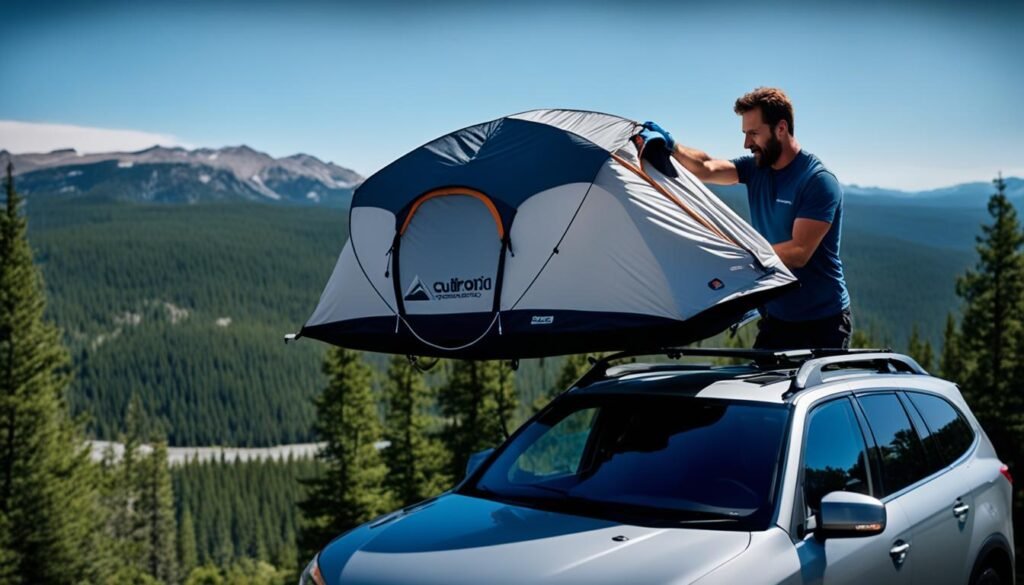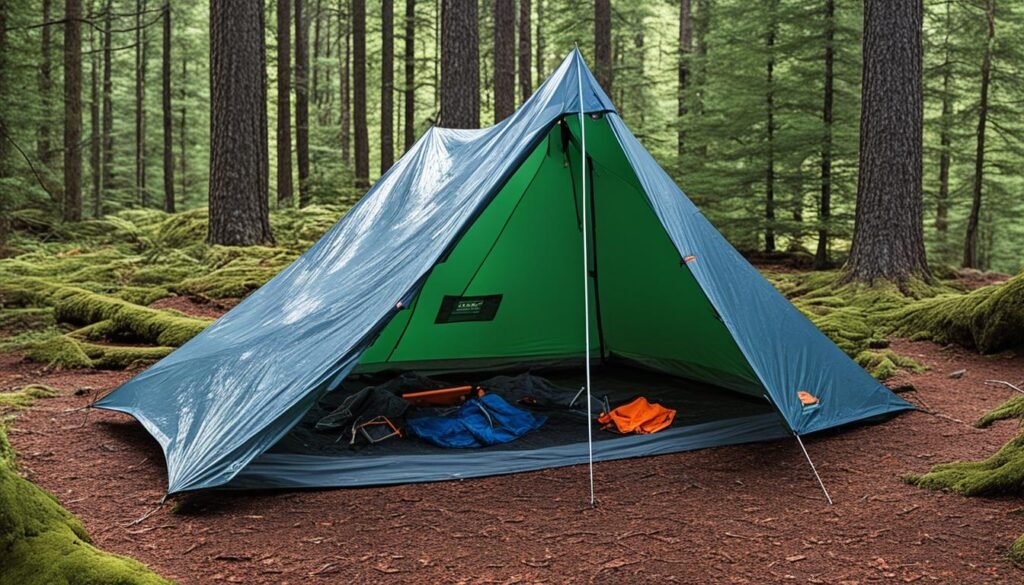Embarking on an outdoor adventure, I find myself indebted to my rooftop tent for elevating camping to a new level of comfort. Navigating the intricacies of how to lift a rooftop tent is as essential as the experiences it provides. Not only does the tent’s material showcase resilience, being waterproof and UV-resistant, but it’s also susceptible to damage if mishandled or improperly stored.
Understanding the nuances of lifting techniques for a roof tent is a non-negotiable skill for me, bearing in mind the eventual need for storage. Seasonal changes and planned breaks from the wilderness call for exacting methods to dismount and stow away my portable abode. By respecting the rooftop tent setup guide, I’ve been successful in maintaining the pristine condition of my tent through seasons of use and disuse alike.
Properly lifting off the tent from my vehicle demands shrewd tricks and the application of buffers, like wooden platforms, to shun dampness and preserve my tent’s longevity. Wrapped carefully and poised on supports off the floor, my tent avoids the pitfalls of direct contact with moisture-inviting surfaces, assuring readiness for my next outing.
Key Takeaways
- Proper lifting is critical to maintain the longevity of a rooftop tent.
- Utilizing proper lifting techniques and safety measures avoids damage.
- Damp-proof storage solutions are vital for preserving the tent’s quality.
- Regular maintenance and checks ensure the rooftop tent’s durability.
- Enlisting assistance and using the right tools lead to a safer setup process.
- Adherence to a setup guide contributes to an optimal outdoor experience.
Understanding the Basics of Rooftop Tents
My journey with a rooftop tent has transformed the way I embrace the wilderness, bringing convenience and added safety into my camping experience. I’ve come to appreciate the unique rooftop tent advantages that elevate outdoor adventures far above the ordinary ground tent camping.
Benefits of Opting for a Rooftop Tent
The allure of a rooftop tent comes from a fusion of practicality and innovative design. Among many, one essential benefit is the added security from nocturnal ground-dwelling animals, a real concern in the wild. The tent’s elevation not only keeps me above any curious wildlife but also provides enhanced insulation from the cold ground, leading to a warmer, more comfortable sleep. Additionally, the ease of setup is incomparable—most rooftop tents are engineered for swift assembly, transforming my arrival at a camping spot into an almost instant retreat to relaxation.
Identifying the Right Tent for Your Vehicle
An essential step before embracing the mobile high ground is choosing a tent that matches the capability of my vehicle. Not every rooftop tent is suitable for each vehicle, as they vary in size, weight, and load-carrying guidelines. As someone who values safety and convenience, I adhere to roof top tent lifting instructions to determine the best fit. My selection pivots on a tent that can support a significant load, typically around 400 to 800 pounds, without hindering vehicle operation—such as unimpeded access to doors and windows—and one that can be mounted securely, so it doesn’t become a hazard when I’m journeying to my next destination.
As I review my options, considering vehicle compatibility is paramount. It’s not simply about the comfort and features of the tent, but also the structural integrity and capacity of my car’s roof. Following the best practices for lifting a rooftop tent, it’s crucial that I avoid any strain on my roof that could lead to damage or even compromise my safety on the road. This foresight ensures that both my vehicle and rooftop tent are in perfect harmony, paving the way for journeys filled with awe-inspiring experiences and serene nights under the stars.
Preparing for Rooftop Tent Installation
Before I embark on the physical aspect of raising my rooftop tent efficiently, I dedicate time to meticulously prepare my vehicle for the process. This preliminary step is fundamental to guarantee the safety and success of the installation.
Vehicle Assessment and Roof Load Capacity
Ensuring my vehicle is capable of bearing the additional weight of a rooftop tent is a priority. I meticulously examine the suspension, checking shocks and springs for their resilience under the extra load. Occasionally, I’ve found that upgrades or reinforcements are necessary to accommodate the weight and preserve the structure of both my vehicle and the rooftop tent. Each vehicle comes with its roof load capacity, an essential specification that dictates the size and weight of the tent that can be lifted and mounted.
The Importance of a Clean Mounting Surface
A clean start is crucial when adhering to the best rooftop tent lifting methods. By beginning with a vehicle free from debris, I prevent the abrasive damage that dirt could cause during the mounting of the roof rack or tent. A spotless surface is non-negotiable; it not only guards against scratches that could lead to rust but also ensures the mounting hardware adheres properly, making the task of lifting the rooftop tent safe and easy.
Adapting my approach to the unique requirements of my vehicle translates into easy ways to lift a rooftop tent. Spending this initial time preparing for installation has repeatedly paid off, delivering an efficient and secure setup that leads to hassle-free adventures in the great outdoors.
Selecting the Proper Mounting Equipment
Securing my rooftop tent begins long before I reach the trails—it starts with choosing the right rooftop tent mounting solutions. A robust and compatible roof rack installation plays a pivotal role in the tent’s overall safety and stability. From the myriad of options available, selecting a fitting mounting system, such as a roof rack or an exoskeleton, is a decision that should not be taken lightly.
My meticulous approach involves matching the mounting solution to my tent’s specifications precisely. Ensuring the dimensions and load capacities align is crucial to prevent unwelcome movement or detachment when facing the challenges of the open road. Let me share with you the essentials of what to look for in a mounting solution to uphold the utmost rooftop tent safety.
| Mounting Solution Type | Advantages | Considerations |
|---|---|---|
| Roof Racks | Versatility in vehicle compatibility, range of material options | Check vehicle’s roof load capacity, ensure non-obstruction of doors/windows |
| Exoskeletons | Added robustness, can support larger tents | Potential modifications to vehicle, confirm tent dimensions align |
With every trip, my priority is to follow installation instructions with precision and detail. Neglecting even a minor step in the process could mean the difference between a secured rooftop tent and a potential highway hazard. That’s why I meticulously gather the right hardware, bolts, and brackets, and use them just as the instruction manual outlines. Each bolt tightened and each bracket secured fortifies my confidence in a safe journey.
To illustrate, I remember the first time I installed my rooftop tent. I took extra time to study the instructions provided with the roof rack system, assuring every step accounted for, every tool prepared, before beginning. And I was rewarded with not only a seamless installation but also peace of mind, knowing that my tent was as secure as it could possibly be. After all, overlooking the importance of proper mounting equipment can risk both your gear and your getaway.
What resonates within me is not simply the thrill of exploration but the wisdom to embark on my adventures with assurance and responsibility. Thus, establishing rooftop tent safety and security through the correct mounting equipment is paramount—it’s the foundation of confident and worry-free outdoor escapades.
How to Lift Roof Top Tent: Step-by-Step Guide
When it comes to setting up my rooftop tent, I ensure every step is taken with safety and precision at the forefront. The process of lifting and affixing the tent onto my vehicle can’t be rushed—it calls for a methodical approach that respects both the product’s integrity and my personal well-being. Let’s step into the world of correct rooftop tent handling, an aspect of the adventure often overshadowed by the excitement of the destination itself, yet equally critical.
Gathering the Necessary Tools and Equipment
First, I begin by collecting all the necessary tools and equipment. It’s almost like a ritual, where I lay out the hardware, read through the manufacturer-provided safe rooftop tent lifting guide, and do a roll call of sorts for every bolt, bracket, and wrench. This demands patience and attention to detail, ensuring that each component is ready and on standby for the lifting process. Failure to do so might result in a hiccup that could cost me valuable time or, worse, compromise the tent’s safe installation.
Instructions for Safe Tent Lifting
With all tools at the ready, I proceed to the lifting phase, where precision meets effort. Following the roof top tent setup techniques as prescribed by the tent manufacturer, I recruit a companion because this is not a solo endeavor—the risk of damaging the tent or injuring myself becomes too high without assistance. Together, we execute a coordinated lift, mindful of our posture and the balanced distribution of the tent’s weight, maintaining a steady pace as we guide the tent up and onto the vehicle’s roof rack.
Once atop, it’s about finessing its position for optimal weight distribution and secure fastening. This is when the heavy lifting transforms into a delicate dance of adjustments and alignments, akin to a puzzle where every piece must fit perfectly. The mental checklist of safe rooftop tent handling constantly runs in the background, directing each move until the tent sits proud and firm, promising shelter and serenity in my forthcoming sojourns into nature.
Through these practices, I’ve adopted a thorough understanding of the journey’s groundwork—literally lifting the experience from the mundane to the magnificent. And so, my commitment to the art of rooftop tent setup extends beyond the material; it’s an embrace of the anticipation for the adventures that lie ahead.
Securing the Rooftop Tent to Your Vehicle
As an avid camper who treasures the camaraderie with nature, ensuring that my rooftop tent is fastened securely is a task I approach with both excitement and precision. The art of rooftop tent securing methods involves more than just hefting the tent onto the vehicle—it’s about aligning and affixing the installation components in a way that guarantees my safety, as well as the integrity of the equipment.
From the moment I align the brackets to the last turn of the bolt, I am mindful of the key principles of fastening a rooftop tent safely. This meticulous process is not just a chore; it’s a critical step towards ensuring that my travels remain unmarred by equipment failures or safety breaches.
Weight distribution plays a protagonist in this narrative. It’s essential that the tent’s weight is evenly spread across the roof to forestall any imbalances that could transmute into peril while driving. Underpinning this balance are the robust brackets, bolts, and nuts, each collaborating to secure the tent’s base to the roof rack. My vigilant perfectionism does not falter until I’ve conducted a thorough check, validating the tightness of every fastener and the centered placement of the tent.
Accessibility is not a tertiary concern, either. The installation must respect the vehicle’s design, ensuring that doors, windows, and other features remain unobscured and accessible. Here is where the craft meets caution, and my understanding of rooftop tent installation safety becomes evident.
To elucidate my approach, below is a table underscoring the key components I deploy in the securing process—each chosen judiciously to fulfill its duty without compromise:
| Installation Component | Function | Criteria for Selection |
|---|---|---|
| Brackets | Connect tent to roof rack | Durability, proper fit for vehicle and tent model |
| Bolts and Nuts | Fasten brackets securely | Adequate size and tensile strength for weight |
| Weight Distribution | Ensure balanced load | Even spread across roof to maintain vehicle stability |
Fulfillment in securing my tent is not merely derived from ticking off a checklist. It’s born from the confidence that no road unwinds too long or turn too steep, no journey too audacious. It’s the assurance of safety, the guarantee of my tent’s fidelity to its rooftop perch, and the promise of adventures devoid of preventable mishaps.
Perfecting Positioning and Weight Distribution
As I turn to the essential task of positioning my rooftop tent for the optimal outdoor experience, I recognize the significance of precision in tent weight distribution on my vehicle. Ensuring the balance is quintessential, not only for the functionality of my tent but also for safety during transit. The interplay between the rooftop tent positioning and the aerodynamics of the vehicle cannot be overemphasized—it introduces a delicate, yet a critical aspect that requires careful consideration as I prepare for my travels.
Ensuring Even Weight Across Your Roof
The need to evenly distribute weight across the roof of my vehicle is a principle I abide by meticulously. The harmonious distribution of the tent’s heft does more than just facilitate a balanced ride—it ensures the structural integrity of my vehicle isn’t compromised. By centering my tent on the vehicle roof, I safeguard my investment and allow for peaceful navigation, irrespective of the terrain or distance traversed.
Adjusting Position for Aerodynamics and Accessibility
The consequence of neglecting the rooftop tent aerodynamics could manifest in reduced fuel economy and added stress on my vehicle during high-speed travel. Thus, I take considerable care in adjusting my tent’s position to complement the wind flow around the vehicle. In parallel, I am watchful to guarantee unobstructed accessibility to my vehicle’s doors and cargo to maintain functionality without compromising on the outdoor convenience.
| Component | Position Adjustment | Impact on Aerodynamics | Impact on Accessibility |
|---|---|---|---|
| Foward/Backward Positioning | Centered for even weight | Reduce wind resistance, increase fuel efficiency | Ensures door functionality, ideal for cargo access |
| Lateral Positioning | Aligned with vehicle’s width | Minimizes side wind impact | Prevents obstruction to side mirror view and side access |
| Vertical Positioning | Lowest possible profile without compromising ground clearance | Decreases drag, maintains speed and stability | Allows for rooftop cargo additions if necessary |
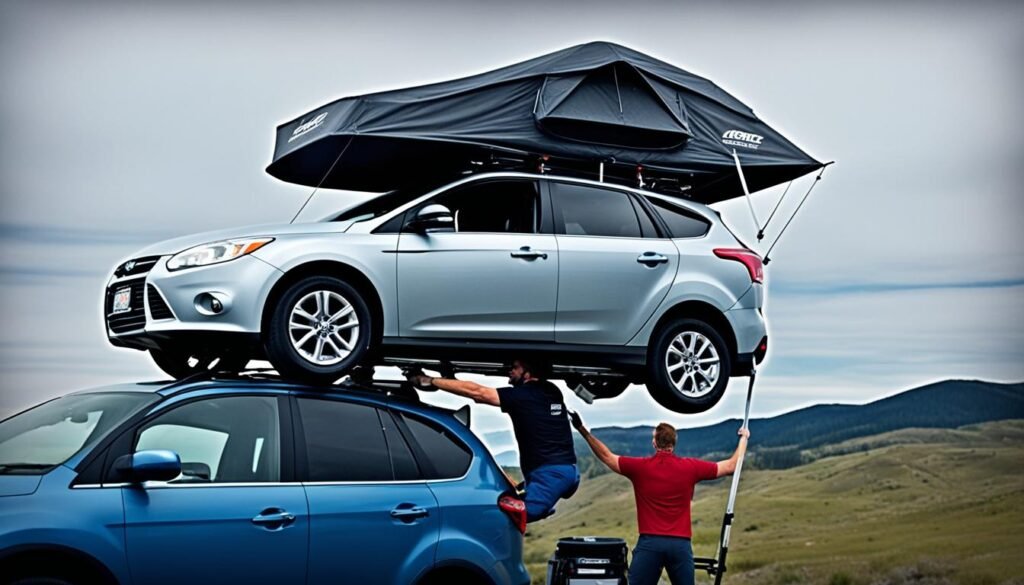
Best Safety Practices During Rooftop Tent Setup
The thrill of outdoor exploration amplifies with a rooftop tent as part of my gear. But to ensure the experience remains exhilarating, and most importantly, safe, I dedicate meticulous attention to the setup process. Rooftop tent safety practices involve more than just following a set of instructions; they require a comprehensive understanding of manufacturer guidelines for tent setup and a keen awareness of rooftop tent weight considerations.
Experience has taught me that success in this aspect of adventuring lies in the details. Each step, from reading the manufacturer’s manual to evaluating the weight capacity of my vehicle’s roof, forms part of a critical safety checklist that cannot be overlooked. By doing so, I venture out knowing that my temporary home atop my vehicle is secure and ready for whatever landscape I decide to settle on.
Adhering to Manufacturer Guidelines and Weight Limits
It’s essential to respect the designed capabilities of my tent. I go over the manufacturer’s instructions to understand not only how to set the tent up but also to grasp the important safety cues integrated within. This includes verifying the tent’s weight, which plays a pivotal role in rooftop tent safety practices. Ensuring that my vehicle can support the tent, both stationary and in motion, is non-negotiable—it’s a practice that promises to keep my journeys hazard-free.
Working with an Assistant for Optimal Safety
Despite my seasoned camper status, I never attempt to install my rooftop tent single-handedly. Working with an assistant not only makes the process more efficient, it enhances safety, providing mutual support and an additional set of eyes to spot any potential issues. We maintain three points of contact with the ladder and choose a level ground to anchor, aiding in preventing precarious placement that could lead to accidents or damage.
It’s all about partnership and precision. Together, we take precautions to avoid open flames inside the tent and to secure all items before departure. As I’ve learned, overlooking these critical steps isn’t worth the risk—they’re the underpinning elements of a responsible and satisfying outdoor venture.
Embarking on my next expedition, my rooftop tent not only promises a haven in the wild but also stands as a testament to diligent practice and safe conduct. This is where excitement meets reliability, where adventure pairs with prudence.
Rooftop Tent Lifting Techniques for Solo Campers
Embracing the solitude of the wilderness as a solo camper, I have encountered numerous occasions where I’ve needed to lift and install my rooftop tent without the aid of a companion. My resilience has driven me to develop single camper rooftop tent lifting techniques that emphasize safety and efficiency, even though the inherent risks dissuade many from attempting the individual rooftop tent installation process alone.
Through experience, I’ve honed these solo techniques for tent setup, utilizing the structure and features of my vehicle to cautiously maneuver the tent into position. Let me walk you through a table that outlines my methods and considerations which I turn to when faced with the task of single-handedly lifting my home away from home.

| Technique | Description | Safety Precautions |
|---|---|---|
| Back-Up Lift | Back the vehicle up to an elevated surface to reduce lifting height. | Ensure vehicle is stable and e-brake is engaged to prevent rolling. |
| Leverage Ramps | Use ramps to roll the tent up to roof level gradually. | Double-check ramp stability and security before lifting. |
| Winching System | Implement a pulley system attached to a stable structure for lifting. | Test the winch for strength and ensure clear path for tent movement. |
| Incremental Steps | Lift the tent to the vehicle in manageable increments, using rests. | Constantly monitor physical exertion and take breaks as needed. |
Although these methods have served me well, caution can never be overstressed. The risk of personal injury or potential damage to the rooftop tent is amplified when handling the weight individually. Every step must be executed with planned precision, and I often reassess the approach for each new terrain and situation, ensuring that my solo camping continues without mishap.
The aim is to strike a balance between independence and safety. The allure of the wild often comes unaccompanied, yet with the right approach and a deep respect for the demands of rooftop tent handling, the solo camper can rise to the occasion, quite literally lifting their shelter to new heights.
Maintaining Your Rooftop Tent When Not in Use
For an enthusiastic camper, understanding the nuances of rooftop tent maintenance is a testament to their devotion to the outdoor lifestyle. The commitment to preserving my rooftop tent involves a multi-faceted approach to upkeep, especially when the gear is resting between adventures. This isn’t just about dutifully storing rooftop tents; it’s an exercise in ensuring longevity and reliability.
Proper Storage to Prolong Tent Life
When the echoes of the wild temporarily fade, the steps I take towards storing my rooftop tent are disciplined and thoughtful. The emphasis is on securing the tent against potential harm while it awaits the next journey. Knowing that impeccable storage means easy mobilization, I prioritize creating an environment that repels moisture and maintains the integrity of the materials.
Securing my tent atop a dry platform or adequately suspended in a space that shields it from the elements forms the core of my process. This extra layer of protection hedges against dampness—a silent adversary of outdoor equipment.
Cleaning and Damage Checks Before Reinstallation
Before setting out onto the next trail, I delve into checking the rooftop tent for damage. This step is as much about reassurance as it is about readiness. Scanning for tears, ensuring zippers glide smoothly, and verifying the structural soundness of poles and fabric is essential. Lubricating moving parts and treating the material with UV-resistant products, I do so with an understanding that these are not mere tasks, but rituals that honor past trips and anticipate future expeditions.
| Maintenance Task | Action | Purpose |
|---|---|---|
| Cleaning | Vacuum and wipe with appropriate cleaners | Remove debris, prevent mold, and maintain fabric quality |
| Inspection | Check for tears, seam strength, and zipper performance | Identify potential failures and repair them preemptively |
| Protection | Apply UV protectant sprays | Preserve material against sun damage and fading |
| Lubrication | Treat zippers and pivot points with a silicone lubricant | Ensure easy operation and protect against corrosion |
The virtues of being meticulous with rooftop tent maintenance aren’t lost on me. It’s a practice that mirrors the respect I have for the natural world—knowing that how I care for my gear affects not just the duration, but the quality, of my time spent under the vast sky.
Efficiently Raising Your Rooftop Tent for Quick Set-Up
The art of an efficient rooftop tent setup becomes second nature with practice and preparedness. At the heart of my technique is a streamlined process that assures a quick rooftop tent raising experience every time. Through meticulous planning and a personal checklist, I achieve a fast roof top tent installation that leaves more time to enjoy the serenity of the great outdoors.
- Pre-trip inspection ensures all components are pristine and fully functional.
- Custom checklist covers every detail from tent fabric to hardware integrity.
- A rehearsal of setup at home prevents fumbles in the field.
- Marking optimal tent placement on my roof rack facilitates immediate alignment upon arrival.
Once at the campsite, speed is complemented by precision. My routine includes verifying that the tent is balanced with equal weight distribution to prevent any undue stress on my vehicle’s roof. Furthermore, I ensure the ladder’s stability and operation are flawless before concluding the installation process.
| Component | Checklist Item | Outcome for Quick Set-Up |
|---|---|---|
| Tent Material | No rips or tears | Assures durability and resistance against weather |
| Hardware | All bolts, nuts, and joints accounted for | Ensures safe and secure mounting |
| Ladder | Smooth extension and retraction | Quick and reliable access |
| Balancing | Check on level ground | Stable sleep surface, prevents vehicle tilt |
Executing these checkpoints is not just about efficiency; it’s about cultivating a routine that lends itself to enhancing my camping experience. Time saved on setup means more time spent reveling in nature’s beauty, resting assured that my home above the ground is perched securely and ready for the night’s embrace.
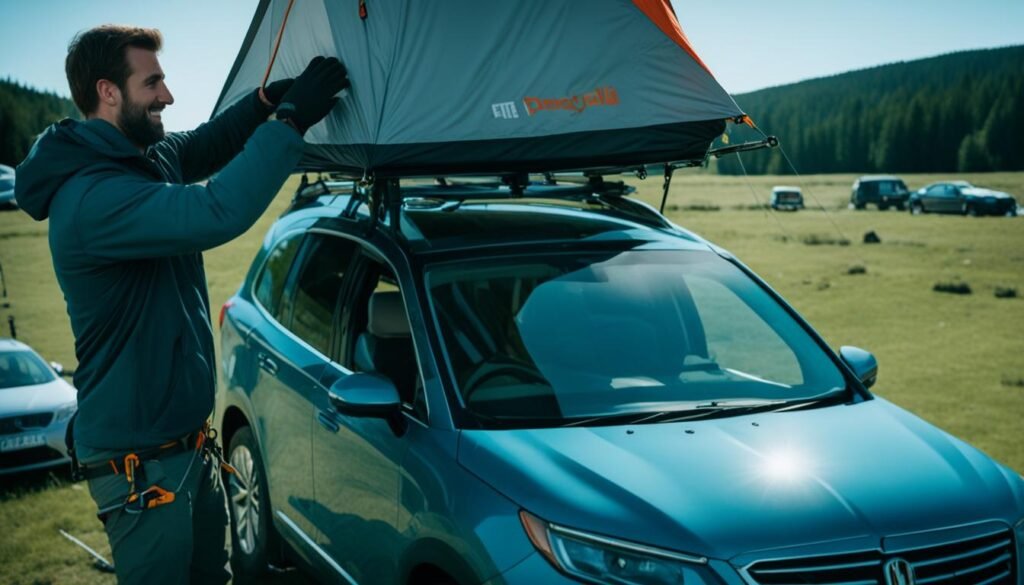
Challenges of Lifting and Solutions for Common Issues
As a seasoned camper, I’ve faced my fair share of challenges when it comes to handling heavy rooftop tents. While these tents offer convenience and comfort, they also bring installation challenges that can prove daunting, sometimes even discouraging, to outdoor enthusiasts. With some rooftop tents weighing in excess of 100 pounds, the process of mounting and dismounting these systems is no light task—literally.
The key to overcoming tent lifting issues lies in both preparation and execution. Innovative methods and tools can aid in reducing the physical burden and risk of injury. It is pivotal to understand that each rooftop tent installation provides its own set of obstacles which may require unique solutions. Through my encounters, I can attest that a well-devised plan and the right techniques make all the difference.
Addressing Difficulties with Heavy Rooftop Tents
Addressing the weight of a rooftop tent begins with the right groundwork. It’s not merely about muscling through; it’s about smart, strategic action. Understanding how to navigate the sheer bulk of these tents involves using mechanical aids where necessary and modifying lifting techniques that ensure I, and my camping companions, don’t succumb to strains or injuries during the installation process.
For many times, lifting and anchoring the tent to my vehicle’s rack involved more than just brute strength. Tools like pulley systems, lifting aids, and even leveraging the natural terrain provided me with mechanical advantage and simplified the hoisting process.
Strategies for Overcoming Obstacles During Installation
When it comes to rooftop tent installation challenges, I’ve seen it all—from limited installation space to misaligned components. Recognizing these obstacles upfront is as crucial as finding the solutions to troubleshoot them. Foresight and anticipation allow me to prepare for complications, such as ensuring all components are aligned and readjusting my approach to fit the constraints of the given space.
Returns and adjustments are part of the process—whether it’s the need for additional shims to achieve a level mounting surface or rearranging cargo to distribute weight more effectively. These adjustments may seem minor, but they play a significant role in ensuring that the tent is mounted correctly and securely. An improperly installed tent is unsafe and can spell disaster for any camping trip.
Allow me to share a table that has become an essential part of my installation toolkit—a troubleshooting guide that assists me in innovating solutions on the go:
| Obstacle | Strategy |
|---|---|
| Insufficient lifting strength | Use mechanical aids like pulleys or winches |
| Limited space for installation | Clear surrounding area, use compact tools |
| Misaligned tent and vehicle rack | Adjust position with shims or reposition vehicle |
| Weather factors | Choose a calm day, use protective gear |
The effort I put into navigating these trials ensures not just the longevity of my rooftop tent but also the safety and enjoyment of my camping escapades. Overcoming tent lifting issues speaks to the resilience and adaptability required for true outdoor enthusiasts. As I continue to challenge my limits, I find that with each trial, comes greater knowledge and an even deeper appreciation for the art of setting up my shelter in the wild.
Tips for Lifting Rooftop Tents in Extreme Weather Conditions
The endeavor of lifting a rooftop tent in weather that is less than ideal presents a unique set of challenges that demand special attention and care. Whether I’m setting up camp as rain begins to pour or dismantling my elevated haven in the aftermath of a storm, my actions are guided by the understanding that both the tent’s longevity and my safety hinge on the measures I take to counter the elements.
Protecting Your Tent from Weather-Related Wear and Tear
Tent protection in extreme conditions begins with the selection of robust coverings designed to shield the fabric from the onslaught of nature’s forces. A weather-resistant, durable tent cover is the first line of defense against the harsh elements that can accelerate wear and tear. As I navigate through the variable weather conditions, I ensure that the cover is secure and in good condition to stave off any potential damage.
After each journey, rigorous cleaning and drying of the tent material are critical to prevent mold and mildew—the enemies of any fabric dwelling. My focus lies on ensuring that the tent is completely dry before folding and storing, as even a hint of dampness can initiate deterioration.
Critical Guidelines for Safe Installation in Adverse Weather
Adverse conditions introduce risks not only to the tent’s material but also to the installation process itself. To ensure installation safety in adverse weather, my approach is rooted in awareness and preparation. I follow these guidelines:
- Always check the forecast before planning the lifting or installation of my rooftop tent, hence avoiding severe weather that could endanger safety.
- In windy conditions, I secure loose materials and employ additional hands to prevent the tent from becoming a sail.
- Utilize non-slip gloves and secure footing to prevent accidents, especially when surfaces become slick.
- When snow or ice is present, I clear the vehicle’s roof entirely before attempting to install or remove the rooftop tent to avert slipping or ice causing unbalanced weight distribution.
- During periods of extreme cold, I make sure that all moving parts, like zippers and clasps, are functioning and not seized, to prevent breakage during use.
These proactive steps are my mantra to shield my rooftop tent from the unpredictable moods of the weather, prolonging its life and ensuring the consistency of my camping experiences no matter the season.
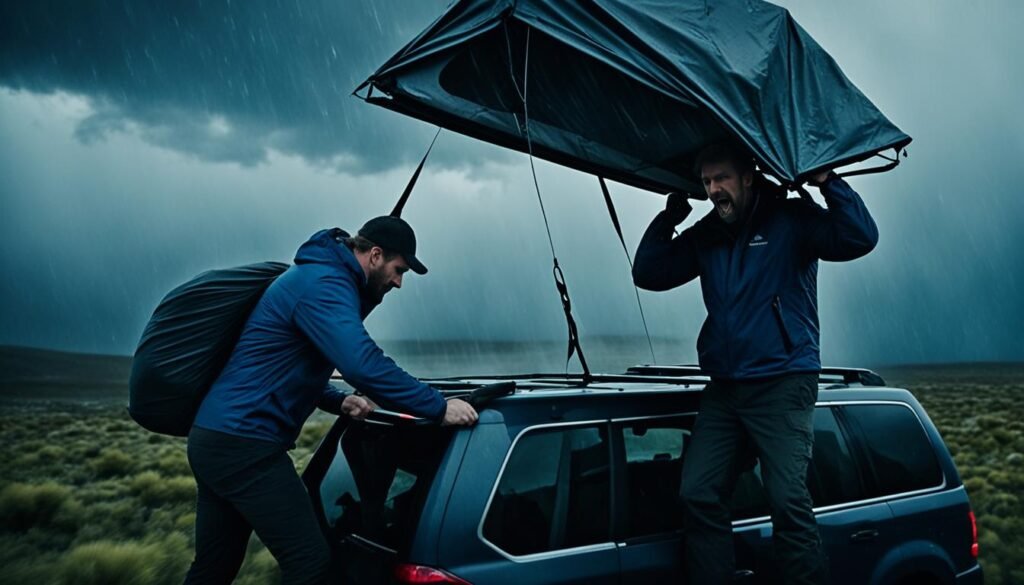
No matter the destination or the conditions it presents, a well-maintained rooftop tent, coupled with a vigilant approach to safety, offers the assurance that the journey—and the tales that come with it—will be preserved not only in memory but in the condition of the gear that carries me through each adventure.
How can I safely lift and install a rooftop tent by myself?
When installing rooftop tent solo, it’s important to ensure you have the right equipment and knowledge. Start by lifting the tent onto the vehicle, securing it with tie-downs. Use a sturdy ladder to climb up and carefully follow the manufacturer’s instructions for proper installation. Safety is crucial throughout the process.
How Can I Safely Lift and Secure a Rooftop Tent in Windy Conditions?
When dealing with windy conditions, it is crucial to secure your tent against wind to avoid potential hazards. Use heavy-duty straps to firmly secure the base of the rooftop tent to your vehicle’s roof rack. Additionally, consider using extra guy ropes and stakes to anchor the tent to the ground for added stability.
Conclusion
In the grand tapestry of adventures, effective rooftop tent strategies stand out as the threads that hold the experience together. The summation of my outdoor pursuit echoes with the rhythm of careful planning, precise execution, and thoughtful preservation. As I cast a retrospective gaze over the many phases of rooftop tent utilization—from meticulous selection and vigilant installation to methodical storage—the collective wisdom gleaned is invaluable. My final thoughts on rooftop tent lifting are steeped in the satisfaction derived from mastery over the elements and a keen sensibility towards the gear that sustains my expeditions.
Summarize tent setup success, and the essence of my approach crystallizes into a methodical practice: begin with a thorough assessment, proceed with systematic assembly, and culminate in protective rest. Rigorous adherence to manufacturer instructions safeguards not just the moments of repose but also the integrity of my rooftop haven. Each touchpoint—whether it be the harnessing of brackets or the securing of a bolt—is executed with an eye for longevity and an anticipation for the next departure into the wilderness.
Continual maintenance coupled with preemptive safety measures is the lifeline that extends the lifespan of my tent, ensuring that the memories amassed beneath its canopy are as enduring as the fabric itself. Through the munificent combination of discipline and enthusiasm, I wield the tools and techniques to render my outdoor shelter as reliable as it is inviting, affirming that an enlightened approach to rooftop tent lifting is elemental to sustained adventure.
FAQ
What are the benefits of opting for a rooftop tent versus a traditional ground tent?
Rooftop tents offer several advantages including safety from ground-dwelling animals, better insulation, ease of setup, and the convenience of not having to find a level camping spot. Their sturdy construction and elevated sleeping area make for a comfortable camping experience.
How do I identify the right rooftop tent for my vehicle?
To find the right rooftop tent for your vehicle, you need to check your vehicle’s roof load capacity to ensure it can support the tent’s weight. The tent should not obstruct your vehicle’s doors or windows and should fit securely on your roof rack or mounting system.
What should I check in my vehicle before installing a rooftop tent?
You should assess your vehicle’s suspension, shocks, and springs to make sure they’re capable of handling the extra weight. Modifications might be necessary for some vehicles to maintain safety and performance.
Why is having a clean mounting surface important?
A clean mounting surface prevents abrasions and potential damage to both the rooftop tent and your vehicle’s roof. It also ensures that the mounting hardware can be installed correctly, providing a safe and secure base for your tent.
What type of mounting equipment do I need for my rooftop tent?
You need a roof rack or an exoskeleton that matches the dimensions and specifications of your rooftop tent. The right mounting equipment will provide optimal security and stability for your tent while you’re driving.
Can you provide a step-by-step guide on how to lift a rooftop tent onto a vehicle safely?
Yes, to lift a rooftop tent safely, gather all necessary tools and equipment, enlist the help of at least one other person, and follow the manufacturer’s instructions. Lift the tent onto the roof rack or mounting system carefully and secure it with the appropriate brackets and fasteners.
How should I secure my rooftop tent to my vehicle?
Secure your rooftop tent by aligning it on the roof rack and fastening the supplied brackets, bolts, and nuts. Make sure the weight is distributed evenly and that the tent does not hinder access to your vehicle’s doors, windows, or features.
How do I ensure even weight distribution of the rooftop tent on my vehicle?
Ensuring even weight distribution involves centering the tent on the roof rack and checking that no side is significantly heavier than the other. This helps maintain balance and effective weight distribution for safe driving.
What safety practices should I follow during rooftop tent setup?
Always adhere to the manufacturer’s guidelines and weight limits, maintain three points of contact when climbing onto the ladder, and ensure you are working on a flat surface. It’s also important to have an assistant to help with the lifting and securing of the tent.
Is it possible to lift a rooftop tent solo, and how?
While it is possible for a single camper to lift a rooftop tent, it is not recommended due to the increased risk of personal injury or damage to the tent. If necessary, experienced solo campers use mechanical aids or leverage against the vehicle and surroundings to assist in lifting the tent.
How do I maintain my rooftop tent when it’s not in use?
Proper maintenance includes cleaning out dirt and debris, ensuring the tent is dry before storage, and regular inspections for any signs of wear or damage. Protect pivot points and zippers with lubrication and use UV-resistant products to preserve the canopy material.
How can I efficiently raise my rooftop tent for quick setup?
Develop a methodical process and checklist that allows for a swift deployment of your tent upon arrival at your campsite. This includes making sure the tent is balanced, the ladder is securely attached, and all components are present and in good condition.
What are some common challenges when lifting heavy rooftop tents and solutions to these issues?
Challenges with heavy rooftop tents can include difficulty managing the weight and potential for injury. Solutions include using lifting aids, adjusting techniques to mitigate strain, and thoroughly planning the installation process to avoid common obstacles.
What precautions should I take when lifting rooftop tents in extreme weather conditions?
When lifting rooftop tents in extreme weather conditions, be sure to use appropriate coverings to protect the tent, clean and dry it thoroughly after use, and handle it carefully to avoid slipping or dropping it. Always adhere to safety guidelines relevant to the specific weather you are facing.

